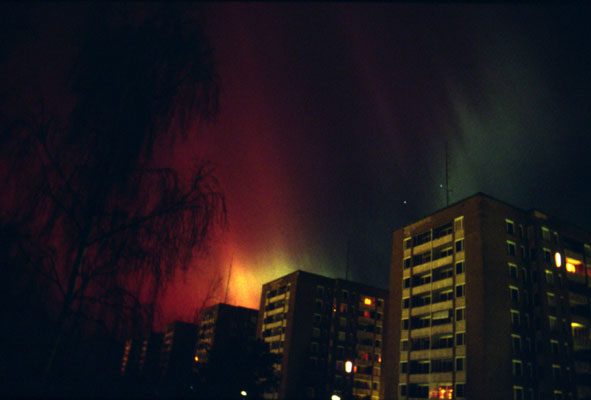Aurora Borealis? Anyone?
I'm wondering if anyone in Russia has seen them. My Latitude is 47 N.
Cloudy last night and rain predicted for tonight too.
Aurora Borealis? Anyone?
I'm wondering if anyone in Russia has seen them. My Latitude is 47 N.
Cloudy last night and rain predicted for tonight too.
I'm easily amused late at night...
Moscow must be too far South to see it. Almost all the regular users of this site are in Moscow.
You need to be close-ish to the Arctic circle to see it regularly. Murmansk would probably be a good spot, in Russia - or Magadan. We get them in Sweden too, but not normally in Stockholm.
Edit: Found this on youtube. Green is the "regular" colour. It's a bit more unusual and cooler with purple.
I have seen these in the middle of winter on prairies. It was in southern Manitoba, ~49.5 deg N latitude. They are like ghosts. Green. Way in distance to north.
They are easiest to see where there are no street lights or other light pollution.
I only speak two languages, English and bad English.
Check out the MasterRussian Music Playlist
Click here for list of Russian films with English subtitles and links to watch them.
Novosibirsk's latitude is about 55N (approx the same as for Moscow), I've never seen anything like that.
So Long, and Thanks for All the Fish
I've seen it in Washington State, USA. Many times. It's amazing.
Вот потому, что вы говорите то, что не думаете, и думаете то, что не думаете, вот в клетках и сидите. И вообще, весь этот горький катаклизм, который я здесь наблюдаю, и Владимир Николаевич тоже…
"The auroral zone is typically 10° to 20° from the magnetic pole defined by the axis of the Earth's magnetic dipole." From wikipedia article about Aurora Borealis.
"The North Magnetic Pole moves slowly over time due to magnetic changes in the Earth's core. In 2001, it was determined by the Geological Survey of Canada to lie near Ellesmere Island in northern Canada at81.3°N 110.8°W. It was estimated to be at
82.7°N 114.4°W in 2005. In 2009, it was moving toward Russia at between 34 and 37 mi (55-60 km) per year.[1]"
So it's not surprising that CoffeeCup hasn't seen them, the band is further north in Russia, and further south in North America.
That makes sense, Seraph. I was wondering why I could see the aurora, but they could not see it in Moscow!! Come to think of it, I never saw the aurora in Sankt-Peterburg, either.
Вот потому, что вы говорите то, что не думаете, и думаете то, что не думаете, вот в клетках и сидите. И вообще, весь этот горький катаклизм, который я здесь наблюдаю, и Владимир Николаевич тоже…
What latitude are Moscow, St Petersburg, and Novosibirsk on, respectively?
I am in Stockholm (59 lat) and apparently we get Northern light 1 night out of 20 here. But I must say I have only seen bright dancing Northern Lights maybe 10-20 times in my entire life. I think it must be much more spectacular further North.
Here is a picture of Northern Light in Stockholm

'Your tax money at work'
.
At end, clearly visible is viewer trajectory NE over lower lake Michigan. Light patterns of cities could probably be identifiable in earlier parts of video. Some looks like midwest, north eastern states, and eastern seaboard. Lots of lightening showing up at times.
Huh? So the compasses really point towards Ellesmere Island in Canada, not the North Pole?"The North Magnetic Pole moves slowly over time due to magnetic changes in the Earth's core. In 2001, it was determined by the Geological Survey of Canada to lie near Ellesmere Island in northern Canada at81.3°N 110.8°W. It was estimated to be at
82.7°N 114.4°W in 2005. In 2009, it was moving toward Russia at between 34 and 37 mi (55-60 km) per year"
I must have been asleep when they talked about this in school.....Could anyone explain it in simple terms?
I shouldn't answer for the physicists, but I'll have a go. The simplest first principle explanation is that the needle of the compass points according to the magnetic field/lines of force at that point. Statistically, this centers on the magnetic pole as located geographically in the vicinity of Ellesmere island, looking just at the direction relative to the surface. The situation is a little more complicated by the occurance of magnetic anomalies that cause some perturbation, usually a small deviation. The compass is constructed to not respond to the vertical component of magnetic field.
http://en.wikipedia.org/wiki/Earth's_magnetic_field
Over geologic history, the magnetic pole of the earth has moved, and even flipped poles. This is evidenced in the magnetic polarization 'frozen' into contemporaneously deposited magnetically active igneous rock. Some examples are in rock on the floor of the Atlantic, in bands parallel to the spreading Atlantic ridge. This is something like a giant magnetic tape, that records the movement and direction of the magnetic pole over geologic time.
It seems that in Murmansk the nothern lights are visible. Were I was in Manitoba was probably very lucky to see the bright kind of aurora, usually need to be more to north. Sky was absolutely clear, very cold, dry, 2 AM. I just about jumped out of skin, because I wasn't expecting it, and didn't know what it was at first. There was no city close by so it could not have been reflected city light.
Я живу на севере Западной Сибири поэтому часто видел это явление. "Северное сияние" - русское название этого природного явления, бывает во время магнитных бурь, поэтому во время Северного сияния часто сильно болит голова, хотя совершенно здоров. Пропадает радио связь.
Russian Lessons | Russian Tests and Quizzes | Russian Vocabulary |